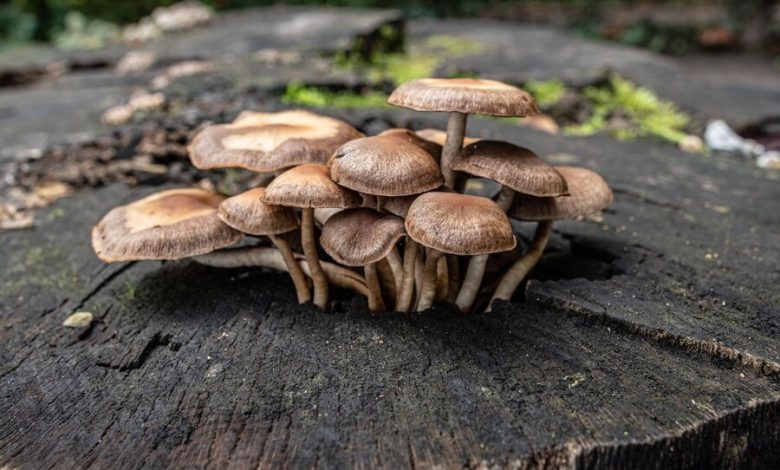The Enigma of Mushrooms Sprouting in Grass: Nature’s Hidden Connections
Nature's Hidden Connection

In the serene world of grassy fields and lush lawns, an enigmatic phenomenon unfolds: mushrooms sprouting amidst the green. These unassuming fungi seem to appear overnight, leaving many to wonder, “Why do mushrooms grow in grass?” In this article, we’ll unravel the mysteries behind these hidden connections and explore the fascinating symbiotic relationships that make this phenomenon possible.
The Dance of Fungi and Grass: An Unlikely Partnership
- A Covert Connection: Beneath the visible surface, a secret underground network of fungal mycelium intertwines with the grassroots, forming a fascinating symbiotic relationship. This connection is the key to understanding why mushrooms flourish in grass.
- Nutrient Exchange: Grasses and fungi engage in a delicate nutrient exchange. While grasses photosynthesize and produce sugars, they also leak some of this energy into the soil. In return, fungi, often mycorrhizal, assist the grass by providing essential nutrients, particularly phosphorus and nitrogen.
- Fungal Fruit Bodies: The mushrooms that sprout above ground are the fruiting bodies of these fungi. They emerge to disperse spores, ensuring the fungi’s survival and the continued health of the grass.
The Beauty of Mycorrhizal Partnerships
- Enhanced Nutrient Uptake: Grasses with mycorrhizal partners can absorb more water and essential nutrients, making them more resilient and able to thrive in a variety of environmental conditions.
- Improved Soil Structure: Fungal networks help build stable soil structures, reducing erosion and improving water retention. This, in turn, benefits the overall health of the grassy ecosystem.
- Natural Pest Control: Mycorrhizal fungi can also deter harmful pathogens, acting as a natural defense mechanism that promotes grass health.
The Life Cycle of a Mushroom
- Spore Dispersal: Mushrooms serve as the reproductive structures of fungi. When they mature, they release millions of spores into the environment, carried away by the wind, rain, or passing animals.
- Germination: When a spore lands in the right conditions, it germinates, forming a new mycelium network underground. This network may eventually lead to the emergence of more mushrooms.
- Environmental Influences: Various factors, including temperature, moisture, and soil quality, influence when and where mushrooms will appear. These factors contribute to the seemingly spontaneous growth in grassy areas.
Why Mushrooms in Lawns and Grassy Areas?
- Rich Organic Material: Lawns and grassy areas often provide a substrate rich in organic material. Fallen leaves, decaying roots, and other organic matter create ideal conditions for mycorrhizal fungi to thrive.
- A Balancing Act: Grasses, in their quest to balance nutrient uptake and energy production, exude excess sugars into the soil. Mycorrhizal fungi find this a welcoming environment to establish their networks.
- Regular Disturbance: Lawns and grassy areas are often subject to frequent mowing, which can inadvertently stimulate mushroom growth. When the grass is cut, it releases stress signals that trigger mushroom development.
A Mycophile’s Dream: Finding and Enjoying Lawn Mushrooms
- Safe for Consumption: Some lawn mushrooms are edible, but caution is advised. Only expert mycologists should identify and consume wild mushrooms, as many varieties are toxic.
- Ecological Importance: Appreciate the role of mushrooms in your lawn’s ecosystem. They contribute to soil health, providing essential services to the grasses that make up your lawn.
- Capture Their Beauty: Instead of eradicating lawn mushrooms, consider capturing their unique shapes and colors through photography. They can add a touch of enchantment to your outdoor space.
Mushrooms and the Circle of Life
- Decomposition and Recycling: Mushrooms are nature’s recyclers. They break down dead organic matter, returning vital nutrients to the soil and perpetuating the cycle of life.
- Food for Many: Mushrooms serve as a food source for a variety of wildlife, from insects to small mammals. They are integral to the food web of grassy ecosystems.
- A Testament to Biodiversity: The presence of mushrooms in your lawn or grassy areas is a testament to the biodiversity and health of the ecosystem. They play a significant role in maintaining the balance of life.
Conclusion: Mushrooms Sprouting in Grass
The appearance of mushrooms in grass is not a mere coincidence; it’s a testament to the intricate web of life beneath our feet. These humble fungi are essential players in the cycle of life, nurturing the grasses they grow alongside. So, the next time you spot a mushroom in your lawn, take a moment to appreciate the fascinating connections that make it all possible.




